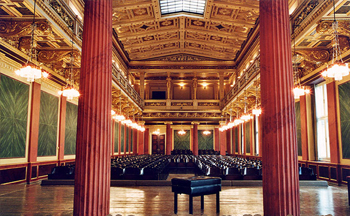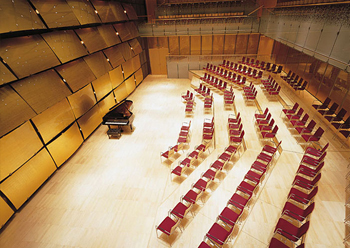Rotterdam Philharmonic Orchestra
December 2025 | ||||||
|---|---|---|---|---|---|---|
Mo | Tu | We | Th | Fr | Sa | Su |
The Rotterdam Philharmonic Orchestra, one of the leading orchestras in the Netherlands, is renowned for its passionate performances and versatile repertoire. Founded in 1980, it has consistently gained international recognition for its excellence. Under the baton of distinguished conductors, the orchestra has performed at major international festivals and in some of the world’s most prestigious concert halls. Known for its dynamic interpretations of both classical masterpieces and contemporary works, the Rotterdam Philharmonic Orchestra has developed a reputation for pushing the boundaries of music. The orchestra also collaborates with top soloists, composers, and conductors, further enhancing its role in the global music scene. It is based in the stunning De Doelen concert hall in Rotterdam, where it regularly presents a diverse range of programs that captivate audiences.
Program and cast
PERFORMERS
Rotterdam Philharmonic Orchestra
Singverein der Gesellschaft der Musikfreunde in Wien
Lahav Shani, conductor
Martha Argerich, piano
Elza van den Heever, soprano
Gerhild Romberger, alto
Daniel Behle, tenor
Kostas Smoriginas, bass
PROGRAM
JOHAN WAGENAAR
Cyrano de Bergerac. Overture, op. 23
ROBERT SCHUMANN
Piano Concerto in A minor, op. 54
– Intermission –
ANTON BRUCKNER
Te Deum
Approximate end: 21:30
7th December 2025
PERFORMERS
Rotterdam Philharmonic Orchestra
Lahav Shani, conductor
Patricia Kopatchinskaja, violin
PROGRAM
DMITRI SHOSTAKOVICH
Violin Concerto No. 1 in A minor, op. 77
– Intermission –
LUDWIG VAN BEETHOVEN
Symphony No. 3 in E-flat major, op. 55, "Eroica"
Approximate end: 21:30
Musikverein Golden Hall
This building is located on Dumbastraße/Bösendorferstraße behind the Hotel Imperial near the Ringstraße boulevard and the Wien River, between Bösendorferstraße and Karlsplatz. However, since Bösendorferstraße is a relatively small street, the building is better known as being between Karlsplatz and Kärntner Ring (part of Ringstraße loop). It was erected as the new concert hall run by the Gesellschaft der Musikfreunde, on a piece of land provided by Emperor Franz Joseph I of Austria in 1863. The plans were designed by Danish architect Theophil Hansen in the Neoclassical style of an ancient Greek temple, including a concert hall as well as a smaller chamber music hall. The building was inaugurated on 6 January, 1870. A major donor was Nikolaus Dumba whose name the Austrian government gave to one of the streets surrounding the Musikverein.
Great Hall - Golden Hall
 “As high as any expectations could be, they would still be exceeded by the first impression of the hall which displays an architectural beauty and a stylish splendour making it the only one of its kind.” This was the reaction of the press to the opening of the new Musikverein building and the first concert in the Großer Musikvereinssaal on 6 January 1870.
“As high as any expectations could be, they would still be exceeded by the first impression of the hall which displays an architectural beauty and a stylish splendour making it the only one of its kind.” This was the reaction of the press to the opening of the new Musikverein building and the first concert in the Großer Musikvereinssaal on 6 January 1870.
The impression must have been overwhelming – so overwhelming that Vienna’s leading critic, Eduard Hanslick, irritatingly brought up the question of whether this Großer Musikvereinssaal “was not too sparkling and magnificent for a concert hall”. “From all sides spring gold and colours.”
Brahms Hall
 "In order not to promise too much it can be said that it has been made into the most beautiful, most magnificent, perfect example of a chamber concert hall that any of us knows in the world.” This was the reaction of a Vienna daily newspaper in October 1993 as the Brahms-Saal was presented to the public after extensive renovation work.
"In order not to promise too much it can be said that it has been made into the most beautiful, most magnificent, perfect example of a chamber concert hall that any of us knows in the world.” This was the reaction of a Vienna daily newspaper in October 1993 as the Brahms-Saal was presented to the public after extensive renovation work.
The surprise was perfect. It was a completely new hall. In contrast to the Grosse Musikvereinssaal, the Brahms-Saal had changed its appearance quite considerably over the years. When and how it acquired that slightly melancholy duskiness that was known to music lovers before 1993 cannot be precisely documented.
Glass Hall
 As a venue for events from concerts to luxury banquets, the Glass Hall / Magna Auditorium is not only the largest of the Musikverein's 4 new halls but also the most flexible in terms of usage.
As a venue for events from concerts to luxury banquets, the Glass Hall / Magna Auditorium is not only the largest of the Musikverein's 4 new halls but also the most flexible in terms of usage.
Hub podiums enable the smooth transformation of the concert hall into a conference centre, the cinema into a ballroom, or the stage into a catwalk. State-of-the-art equipment for sound, lighting, video and widescreen digital projection provide the ideal conditions for half-scenic productions.
The Glass Hall / Magna Auditorium was designed by the Viennese architect Wilhelm Holzbauer. With a height of 8 metres, the hall (including the gallery) can play host to up to 380 visitors.

 EN
EN DE
DE IT
IT FR
FR ES
ES RU
RU JP
JP RO
RO
 Seating plan
Seating plan 

